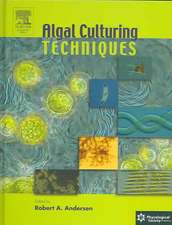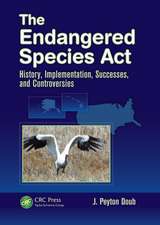Recent Advances in Lichenology: Modern Methods and Approaches in Biomonitoring and Bioprospection, Volume 1
Editat de Dalip Kumar Upreti, Pradeep K. Divakar, Vertika Shukla, Rajesh Bajpaien Limba Engleză Hardback – 13 ian 2015
| Toate formatele și edițiile | Preț | Express |
|---|---|---|
| Paperback (2) | 785.97 lei 38-44 zile | |
| Springer India – 12 oct 2016 | 785.97 lei 38-44 zile | |
| Springer India – 14 oct 2016 | 789.26 lei 38-44 zile | |
| Hardback (2) | 952.72 lei 6-8 săpt. | |
| Springer India – 19 mar 2015 | 952.72 lei 6-8 săpt. | |
| Springer India – 13 ian 2015 | 954.62 lei 6-8 săpt. |
Preț: 954.62 lei
Preț vechi: 1164.17 lei
-18% Nou
Puncte Express: 1432
Preț estimativ în valută:
182.69€ • 198.37$ • 153.46£
182.69€ • 198.37$ • 153.46£
Carte tipărită la comandă
Livrare economică 23 aprilie-07 mai
Preluare comenzi: 021 569.72.76
Specificații
ISBN-13: 9788132221807
ISBN-10: 813222180X
Pagini: 284
Ilustrații: XV, 265 p. 65 illus., 42 illus. in color.
Dimensiuni: 178 x 254 x 21 mm
Greutate: 0.71 kg
Ediția:2015
Editura: Springer India
Colecția Springer
Locul publicării:New Delhi, India
ISBN-10: 813222180X
Pagini: 284
Ilustrații: XV, 265 p. 65 illus., 42 illus. in color.
Dimensiuni: 178 x 254 x 21 mm
Greutate: 0.71 kg
Ediția:2015
Editura: Springer India
Colecția Springer
Locul publicării:New Delhi, India
Public țintă
ResearchCuprins
1. The Influence of Environmental Factors on the Growth of Lichens in the Field.- 2. Sampling and interpreting Lichen Diversity Data for biomonitoring purposes.- 3. Lichens and Particulate Matter: Inter-Relations and Biomonitoring with Lichens.- 4. Monitoring lichens as indicator of atmospheric quality.- 5. Bio-monitoring in western North America: What can lichens tell us about ecological disturbances?.- 6. Community metrics under air pollution stress condition.- 7. Remote Sensing and GIS for Biodiversity conservation.- 8. Reflectance spectra of high altitude lichens based on in-situ measurements.- 9. Lichens as agents of biodeterioration.- 10. Lichen growth and Lichenometry.- 11. Analysis of lichen metabolites, a variety of approaches.
Notă biografică
D. K. Upreti, FNASc, Head of the Lichenology Laboratory, CSIR-National Botanical Research Institute (CSIR-NBRI), Lucknow, has a Ph.D. (1983) in Botany on Studies on the lichen family Cladoniaceae from India and Nepal from Lucknow University under the guidance of Dr. D.D. Awasthi. Dr. Upreti has over 35 years of research experience and has published more than 300 research papers in peer-reviewed journals and coauthored eight books. Apart from taxonomy, Dr. Upreti has also carried out extensive research on ecology, lichen chemistry, pollution monitoring, in vitro culture and biodeterioration studies and bioprospection of Indian lichens. Dr. Upreti was in Antarctica in 1991–1992. He is the Indian corresponding member to the British Lichen Society and International Association for Lichenology.P. K. Divakar has an M.Sc. in Botany and earned his Ph.D. (2002) on Revisionary studies on the lichen genus Parmelia sensu lato in India from Lucknow University. Dr. Divakar is Professor at the Department of Plant Sciences, Faculty of Pharmacy, Complutense University Madrid, Spain. Dr. Divakar has published two books and more than 70 papers in national and international journals. Currently he is editor of Biodiversity and Conservation, Mycokeys, Organisms Diversity and Evolution, and Lazaroa (Iberian Journal of Botany). His research activities center on molecular systematics, genetic diversity, evolution, speciation events, gene mapping, gene flow, TCS estimation of gene genealogies and phenotypic character mapping, ancestral character state, and genomics of fungi that form mutualistic symbioses with algae or cyanobacteria and mycobiont cultures.Vertika Shukla holds an M.Sc. in Organic Chemistry and a Ph.D. (2003) on the Chemical Study of Macrolichens of Garhwal Himalayas from H.N.B. Garhwal University, Srinagar (Garhwal). She is currently working in the Lichenology Laboratory of CSIR-NBRI as a DST scientist and to date she has published more than 50 scientific articles.Dr.Shukla has contributed to secondary metabolite chemistry, spatio-temporal behavior of pollutants in high altitude ecosystems, lichen responses to climate change and the role of lichens in bioremediation of atmospheric fallouts.Rajesh Bajpai has an M.Sc. in Environmental Science and received his Ph.D. in 2009 from Babasaheb Bhimrao Ambedkar (Central) University, Lucknow on Studies on lichens of some monuments of Madhya Pradesh with reference to Biodeterioration and Biomonitoring, is working as a DST scientist in Lichenology Laboratory of CSIR-NBRI, Lucknow. Dr. Bajpai has published thirty research papers in various national and international journals.Dr. Bajpai has carried out extensive research work on the interaction of lichen with the environment, climate-change modeling, arsenic pollution and biodeterioration.
Textul de pe ultima copertă
This book discusses in detail molecular, mycobiont culture, biomonitoring and bioprospection of lichens, providing insights into advances in different fields of lichenology by applying modern techniques and approaches and examining how their application has enhanced or changed classical approaches. It offers a valuable resource, especially for beginners, students and researchers from different academic backgrounds interested in the study of lichens.
In recent years, the introduction of modern analytical techniques and approaches has significantly improved our understanding of the environment, including lichens. Lichens are unique organisms which possess untapped potential as effective and reliable bioindicators, sources of therapeutic phytochemicals, and as excellent extremophiles. The unique and peculiar characteristics of lichens underline the need for a multidimensional approach to explore their potential in various fields of environment science, botany and chemistry.
Modern techniques, especially molecular techniques, have greatly enriched the field of lichen taxonomy and its position in the plant kingdom, revealing little-known species and exploring their evolutionary history, while multivariate analysis and GIS approaches have established lichens as an ideal and reliable tool for monitoring air pollution. Advanced culture techniques have expanded the pharmacological applications of lichens, which was formerly restricted due to their small biomass. The advent of sophisticated analytical instrumentation has now facilitated the isolation and characterization of lichens’ bioactive constituents, even in lower concentrations, as well as the estimation of their stress responses at different levels of pollution. As lichen diversity is adversely affected by increasing air pollution, there is a pressing need to develop effective management practices to conserve, restore anddocument lichen diversity.
In recent years, the introduction of modern analytical techniques and approaches has significantly improved our understanding of the environment, including lichens. Lichens are unique organisms which possess untapped potential as effective and reliable bioindicators, sources of therapeutic phytochemicals, and as excellent extremophiles. The unique and peculiar characteristics of lichens underline the need for a multidimensional approach to explore their potential in various fields of environment science, botany and chemistry.
Modern techniques, especially molecular techniques, have greatly enriched the field of lichen taxonomy and its position in the plant kingdom, revealing little-known species and exploring their evolutionary history, while multivariate analysis and GIS approaches have established lichens as an ideal and reliable tool for monitoring air pollution. Advanced culture techniques have expanded the pharmacological applications of lichens, which was formerly restricted due to their small biomass. The advent of sophisticated analytical instrumentation has now facilitated the isolation and characterization of lichens’ bioactive constituents, even in lower concentrations, as well as the estimation of their stress responses at different levels of pollution. As lichen diversity is adversely affected by increasing air pollution, there is a pressing need to develop effective management practices to conserve, restore anddocument lichen diversity.
Caracteristici
The two volume set provides comprehensive coverage on recent advances in various segments of Lichenology Chapters are contributed by experts working in different fields of lichenology across the world Special focus on biodiversity and conservation, impact of climate change on lichens and ecosystem services of lichen diversity This volume focuses on modern methods and approaches in lichen biomonitoring and bioprospection Includes supplementary material: sn.pub/extras









